
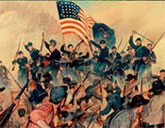
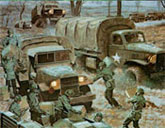
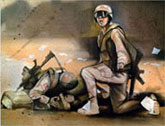
 |
 |
 |
 |
The images above are of the U.S. military throughout the history of the United States. The look of the U.S. military has changed over time, but one thing has remained the same. The U.S. military has always protected the United States and its citizens.
Read the following excerpt from Article VI of the Articles of Confederation:
"No vessels of war shall be kept up in time of peace, by any state, except such number only, as shall be deemed necessary by the united states, in congress assembled, for the defence of such state, or its trade; nor shall any body of forces be kept up, by any state, in time of peace, except such number only as, in the judgment of the united states, in congress assembled,. . ."
Under the Articles of Confederation, the states were responsible for raising a militia and contributing forces in defending the United States only during times of war.
Now, read the following excerpts from Article I, Section 8 of the U.S. Constitution:
"To raise and support Armies, but no Appropriation of Money to that Use shall be for a longer Term than two Years;"
"To provide and maintain a Navy;"
"To make Rules for the Government and Regulation of the land and naval Forces;"
→ Quick Reflection: What differences did you notice regarding the military between the U.S. Constitution and the Articles of Confederation?
Under the Articles of Confederation, states were responsible for contributing troops during times of war. Under the Constitution, Congress has the power to raise a standing army and navy. The Constitution provides constant protection for American citizens.
Immediately following the Revolutionary War, there were several American ships that had been attacked by pirates. The United States's military power consisted of a small army and navy. The constant attacks negatively afftected trade of the new country, which began to take a toll on the fledgling economy. Even though the Treaty of Paris was signed in 1783, there was obviously no freedom of the seas.

This threat to the new nation sparked a debate. Political parties were beginning to form, and this was the perfect opportunity for people to align themselves accordingly. Some feared the establishment of a large national military, believing that it would eventually cause the country to become involved in another large-scale war. They also felt that it was cheaper to pay the ransom that pirates demanded when they captured the ships, while others believed that the United States should establish a national navy to ensure the freedom of the seas.
→ Your Thoughts: Do you believe that the country should have paid the pirates or established a navy? What influenced your choice?
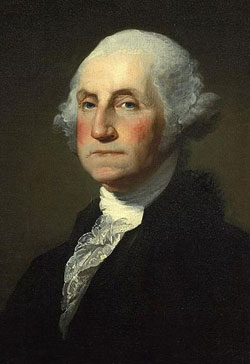
In his annual address to Congress, President George Washington warned Congress, "If we desire to avoid insult, we must be able to repel it; if we desire to secure peace . . . it must be known, that we are at all times ready for war."
In your notes, rewrite the excerpt in your own words and explain what Washington meant. Do you believe that Washington was in favor of establishing a national navy? Give an example from the excerpt to support your opinion.
After much discussion, a decision was made. On March 27, 1794, Congress reestablished the Navy with six vessels in its fleet. In 1797, three ships were launched; the U.S.S. United States, U.S.S. Constellation, and U.S.S. Constitution were the first ships of the new United States Navy.
The Continental Congress established a small navy, but it was no match for the strong and experienced British Navy. From 1775 to 1890, the role of the navy included interrupting the flow of British trade, protecting American merchant ships, and engaging in small battle with British ships. After the Revolutionary War ended, Congress sold off the ships in the navy, noting that the navy had done little to stave off the British naval power.
→ Quick Reflection: How did the establishment of the U.S. Navy help maintain the security of the United States? Do you think that the U.S. Navy provides security for the United States today?
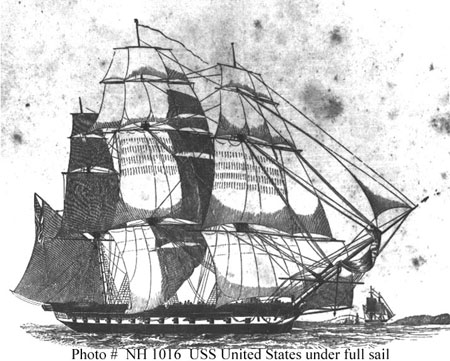
Sources of images used for this section as they appear, top to bottom: